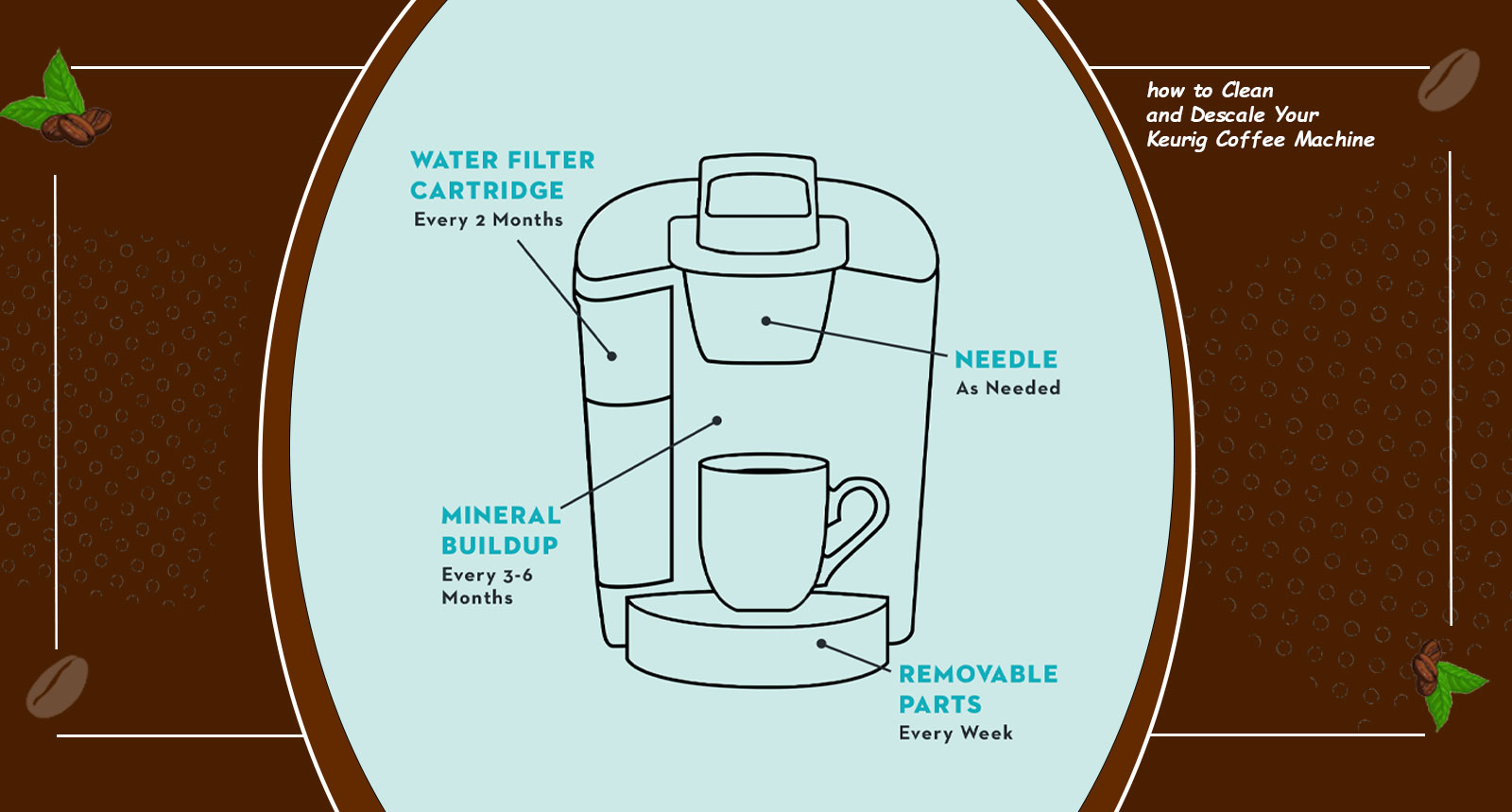Welcome to the world of hassle-free brewing where every cup is a sip of perfection. In this guide, discover the secrets How to Clean and Descale Your Keurig Coffee Machine? To maintaining your Keurig coffee machine at its prime.
Learn the art of cleaning and descaling, ensuring every drop of your favorite brew is as delightful as the first.
Ensuring Your Keurig’s Longevity
Before diving into the details, understand that regular cleaning is not just about impeccable taste – it’s about preserving your Keurig’s longevity.
A well-maintained machine ensures consistent performance and avoids the pitfalls of neglect. Now, let’s delve into the steps to keep your Keurig in top-notch condition.
What Chemical is Used to Descale a Coffee Machine?
Curious about the wizardry behind descaling your coffee machine? Let’s delve into the specifics of the chemical powerhouse that ensures your Keurig stays as good as new.
Power of Citric Acid
Citric acid, a natural acid found abundantly in citrus fruits, emerges as the go-to choice for descaling your coffee machine.
This natural substance is not only effective but also environmentally friendly, aligning with the sustainability ethos that many coffee enthusiasts appreciate.
How Does it Work?
The magic of citric acid lies in its ability to break down limescale and mineral deposits that accumulate in your Keurig over time.
These deposits, if left unchecked, can adversely affect the performance and taste of your beloved brew. Citric acid works its wonders without leaving behind any harmful residue, ensuring that your coffee remains pure and untainted.
Why Citric Acid?
Choosing citric acid for descaling is not only about its effectiveness but also its versatility. It’s safe to use on a variety of materials commonly found in coffee machines, including metal and plastic components.
This makes it a reliable option that won’t harm your Keurig while effectively tackling the stubborn buildup that can compromise its functionality.
Homemade Descaling Solution for Your Keurig Coffee Maker
Curious about a DIY approach to descaling your Keurig? Creating a homemade descaling solution is not only cost-effective but also allows you to control the ingredients. Here’s a simple recipe to keep your coffee maker in top shape:
Ingredients
- White Vinegar: Known for its descaling properties.
- Water: Acts as a neutralizing agent in the solution.
Instructions
- Start by mixing equal parts white vinegar and water. For a standard solution, a 1:1 ratio works well.
- Pour the mixture into the water reservoir of your Keurig. This natural concoction will work its magic in breaking down mineral deposits and limescale.
- Run a brewing cycle without a coffee pod, allowing the homemade descaling solution to circulate through the internal components.
- Discard the used solution and thoroughly rinse the water reservoir to eliminate any lingering vinegar scent.
For a final touch, run a few brewing cycles with plain water to ensure that your Keurig is free from any remnants of the descaling solution.
Step 1: Prepare the Brewer
Embark on the journey to a spotless Keurig by mastering the essential first step – preparing the brewer for a thorough cleaning and descaling process. This sets the stage for a fresh and flavorful coffee experience every time you hit the brew button.
Gather Your Tools
Before you begin, ensure you have the necessary tools at your disposal. Grab a descaling solution, preferably one containing citric acid, a soft cloth, and access to clean, fresh water.
Having everything within reach streamlines the process and ensures you won’t be scrambling midway through.
Power Down and Unplug
Safety first. Make sure your Keurig is powered down and unplugged before you commence the cleaning process.
This minimizes the risk of accidents and allows you to work on the machine without any electrical concerns. Safety is the foundation of a stress-free maintenance routine.
Step 2: Descale the Brewer
Now that your Keurig is prepped and ready, it’s time to tackle the heart of the matter – descaling. This step ensures that any accumulated mineral deposits and limescale are banished, giving your machine a clean slate for brewing perfection. Let’s break down the process:
Prepare the Descaling Solution
Follow the manufacturer’s instructions for your chosen descaling solution, ensuring the right concentration. Typically, a mixture of citric acid and water does the trick. Pour the solution into the water reservoir, ready to work its magic on those stubborn deposits.
Run the Brewing Cycle
Place a large mug or container on the drip tray to catch the descaling solution. Run a brewing cycle without inserting a coffee pod.
This allows the solution to circulate through the internal components, breaking down and flushing away any buildup that might compromise the taste and performance of your Keurig.
Rinse and Repeat (if Necessary)
Once the brewing cycle is complete, discard the used solution and rinse the water reservoir thoroughly. If your Keurig has a lingering scent of the descaling solution, run a few additional brewing cycles with plain water to ensure all traces are eliminated.
With the descaling process completed, your Keurig is now primed for a new era of flavorful coffee. Ready to move on to the next crucial step in maintaining your coffee companion?
Step 3: Fresh Water Rinse
After successfully descaling your Keurig, the next vital step is to give it a refreshing rinse. This ensures that any remnants of the descaling solution are thoroughly flushed out, leaving your coffee machine clean and ready for the next delightful brew. Here’s how to execute a thorough fresh water rinse:
Fill the Water Reservoir
Fill the water reservoir with clean, fresh water. This ensures that the rinse is as effective as possible, leaving behind no traces of the descaling solution that might affect the taste of your coffee.
Run Multiple Brewing Cycles
Initiate several brewing cycles with just water – no coffee pod necessary. This process helps to flush out any remaining descaling solution from the internal components of your Keurig.
Keep a close eye on the water in the mug or container; once it appears clear and odor-free, you can proceed to the next step.
Wipe Down External Surfaces
While the Keurig is performing its rinse cycles, take a moment to wipe down the external surfaces of the machine.
Use a soft, damp cloth to remove any residue or water stains, maintaining not just a clean interior but a polished exterior as well.
With the fresh water rinse completed, your Keurig is now refreshed and ready for the grand finale – the assembly and preparation for your next cup of coffee perfection.
Substitutes for Vinegar for Descaling Your Keurig
While vinegar is a popular and effective choice for descaling your Keurig, there are alternative solutions that can achieve the same stellar results without the lingering scent. If the aroma of vinegar isn’t your preference, consider these alternatives:
Lemon Juice
Harness the natural acidity of lemon juice to break down mineral deposits. Follow a similar process as with vinegar, mixing equal parts lemon juice and water in your Keurig’s water reservoir.
Citric Acid Solution
If you prefer a scent-free option with the descaling power of citric acid, consider using a citric acid solution. This natural compound effectively tackles limescale without leaving any residual odor.
Cleaning Tablets
Explore descaling tablets specifically designed for coffee machines. These convenient tablets often contain a blend of citric acid and other descaling agents, providing a hassle-free and odor-neutral alternative.
Experiment with these alternatives to find the descaling solution that aligns with your preferences, ensuring that your Keurig remains in peak condition without compromising your olfactory experience.
Right Chemical to Descale Your Coffee Machine
Understanding the appropriate chemical for descaling is pivotal to maintaining the longevity and performance of your coffee machine. Let’s explore the primary chemical options for effective descaling:
A Natural Powerhouse
Citric acid stands out as a preferred choice for descaling due to its natural origins. Derived from citrus fruits, it effectively breaks down limescale and mineral deposits without leaving any harmful residue. This eco-friendly option ensures a thorough clean without compromising the flavor of your favorite brew.
Vinegar: A Traditional Descaling Agent
White vinegar, a kitchen staple, is another reliable descaling agent. Its acidity helps dissolve mineral buildup and limescale. While effective, be mindful of the lingering vinegar scent that may require additional rinsing cycles to eliminate entirely.
Descaling Solutions: Tailored Formulas
Commercial descaling solutions often contain a combination of citric acid, acetic acid, or other descaling agents.
These formulations are specifically designed for coffee machines, offering convenience and effectiveness without the need for DIY mixing.
Choosing the right chemical for descaling depends on your preferences, environmental considerations, and the specific needs of your coffee machine.
Now, armed with this knowledge, you can confidently embark on the journey to maintain the peak performance of your beloved coffee companion.
Does Vinegar Pose Risks to Your Coffee Maker?
Vinegar is a widely recognized and effective descaling agent, it’s crucial to be aware of potential risks and use it judiciously to avoid damage to your coffee maker. Let’s explore the nuances:
Potential Risks
– Corrosion Concerns: The acidity in vinegar, while effective for descaling, can potentially contribute to corrosion over time, especially if your coffee maker has metal components. Regular and prolonged exposure may accelerate wear and tear.
– Residual Odor: One notable drawback is the lingering scent of vinegar. Despite thorough rinsing, traces of the odor may persist, affecting the taste and aroma of your coffee. This can be a particular concern for those with a heightened sensitivity to smells.
Mitigation Strategies
-Dilution is Key: To minimize the risk of corrosion, always dilute vinegar with water before using it in your coffee maker. A common ratio is equal parts water and vinegar.
-Thorough Rinsing: After the descaling process, run multiple brewing cycles with plain water to ensure all traces of vinegar are thoroughly flushed out. This step helps mitigate both the risk of corrosion and residual odor.
Consider Alternatives
If you’re concerned about the potential risks associated with vinegar, consider alternative descaling options such as citric acid solutions, lemon juice, or descaling tablets specifically designed for coffee machines.
By using vinegar cautiously and employing proper mitigation strategies, you can harness its descaling power without compromising the integrity of your coffee maker.
Frequently Asked Questions (FAQs)
1. Why is descaling important for a coffee maker?
Descaling is crucial to remove mineral deposits and limescale that accumulate in your coffee maker over time. These deposits can affect the machine’s performance, compromise the taste of your coffee, and even lead to long-term damage if left unaddressed.
2. How often should I descale my Keurig?
The frequency of descaling depends on the hardness of your water and how often you use the machine. As a general guideline, aim to descale your Keurig every 3 to 6 months. If you notice a decrease in performance or the taste of your coffee, it might be time for a descaling session.
3. Can I use regular vinegar for descaling?
Yes, you can use regular white vinegar for descaling. However, it’s crucial to dilute it with water to minimize potential risks such as corrosion and residual odor. Follow the recommended dilution ratio in your descaling process.
4. Are there alternatives to vinegar for descaling?
Absolutely. Alternatives include citric acid solutions, lemon juice, or descaling tablets designed for coffee machines. These options provide effective descaling without the lingering scent associated with vinegar.
5. Can descaling solutions harm the environment?
Many descaling solutions, especially those containing citric acid, are environmentally friendly. Always check the product labels for eco-friendly certifications, and consider DIY options like citric acid or lemon juice for a more sustainable approach.
6. How can I eliminate the vinegar odor after descaling?
To eliminate the vinegar odor, run several brewing cycles with plain water after the descaling process. This helps flush out any remaining traces of the solution. Thorough rinsing is key to ensuring your coffee retains its pure and untainted flavor.

